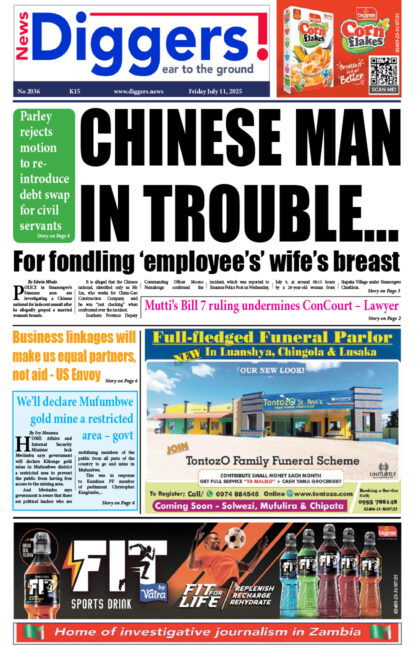Minister of Infrastructure Development Minister Ronald Chitotela says collection of revenue from entry ports during the first quarter of this year jumped to over K186 million, surpassing the K132.4 million collected in the corresponding period last year.
Issuing a Ministerial statement rendered to Parliament, Wednesday, on the road tolling programme in the country, Chitotela disclosed that government recorded an increase in the amount of revenue collected from entry ports and inland toll stations this year.
He announced that government realised more revenue amounting to K186.4 million during the first quarter of this year, up from K132.5 million during the same period last year.
“Mr Speaker, I wish to inform the House that revenue collection under the tolling programme in 2018 has improved compared to previous years. For instance, in the first quarter of 2017, a total revenue collection stood at K132,481,277.27 compared to a total collection in the same quarter of K186,360,686.65 in 2018. This is on account of increase in the collection at some toll stations as well as ports of entry,” Chitotela said.
“Mr Speaker, I also wish to announce that the ports of entry contributed more revenue amounting to K97,550,211.13 in the first quarter of 2017 compared to K34,931,66.14 from the inland toll stations in the same period. The trend was similar in the first quarter of 2018 with the ports of entry contributing K118,572,726.77 compared to K67,733,959.88 from the inland toll stations. As we continue implementing the road construction, rehabilitation and maintenance projects, we will ensure that more focus is given to the roads that are contributing to the revenue collection so that the motorists that are paying the toll fees can get value for their money. Mr Speaker, in the same spirit, government will continue implementing discount measures to mitigate against paying high fees by our frequent and local road users rising within the 20-kilometre radius of toll facilities. The criteria for qualification has been well published.”
He said of the planned 20 inland toll stations that were meant to be commissioned last year, only five commenced operations.
“In 2017, government planned to commission additional 20 inland toll stations on key roads across the country. But out of that number, five stations commenced operations in the latter part of 2017 and these are as follows; Chembe on Mansa to Chembe road in Luapula Province; Kalense on Kasama to Luwingu road in Northern Province and Kateshi on Kasama to Mbala road in Northern Province,” Chitotela explained.
“Chongwe toll station on Great East Road between Lusaka and Chongwe and the Nakonde toll station in Mbala on Mbala – Nakonde road. The three toll stations commissioned in April, 2017, contributed about K96,147,000 in toll revenues as at December 31st , 2017 while the first quarter of 2018 they generated a total of K28,793,000 in revenue. Comparatively, we have noted a decline in toll revenue collection in the first quarter of 2018 at the three toll stations cited above as several motorists accessed toll discounts, which are a relief given to local residents and those who frequently use the respective toll stations. Mr Speaker, as reported earlier this year, collectively, all the toll stations raised a total of K667.9 million in 2017 and we created about 141 direct and permanent jobs for our youths in Zambia. I wish to underline here that from the time the road tolling programme which commenced in November 2013 to date, a total amount of K2.2 billion has been collected from the inland ports of entry and weigh bridge stations of the country, marking it to be the highest none tax revenue contributor to the Treasury.”
He hastened to add that the collected revenue from both the ports of entry and inland toll stations had been used for its intended purpose.
“I am pleased to inform this August House that the revenue collected has been utilised in accordance with the Tolls Act, which states that, ‘the tolls fee or other charges imposed for the use of a toll road and collected by the agents, shall form part of the road fund and shall be used exclusively for the construction, maintenance and rehabilitation of roads’. Mr Speaker, to demonstrate this point, I wish to inform this August House that under the road rehabilitation, government has spent the toll revenue over the years as follows; K142 million in the period 2013 to 2014; K204 million in 2015; K259 million in 2016 and K501 million in 2017. This is for road rehabilitation. Further, under road maintenance, the expenditure was as follows; K199 million in the period 2013 to 2014; K285 million in 2015; K195 million in 2016; K297 million in 2017 and K296 million so far has been spent in 2018. This brings the total expenditure to K2.2 billion from 2013 to date,” narrated Chitotela.
“While seven additional toll stations were operationalised in 2017, government made progress in the construction of conventional toll plazas at Ganetone, which has reached 70 per cent completion. Levy Mwanawasa plaza, which has reached 32 per cent completion; the Kafulafuta toll plaza, which has reached 35 per cent completion; Manyumbi toll plaza which is at 60 per cent completion, but still under procurement following the termination of the official contract; Choma toll plaza, which is at 70 per cent completion, the Solwezi Mutanda, which has reached 80 per cent completion and lastly, Chipata-Katete which is at 45 per cent completion, among others. Once these have been completed, the number of the inland toll stations will be increased to 21. This year, our initial plan was to complete an additional 20 toll stations along some of the roads that were under construction. However, the backlog of uncompleted toll stations from our 2017 plan, we will need to revise our plans, the delay has been mainly because of the funding challenges, which has affected the completion of the roads which are along the toll stations.”



















